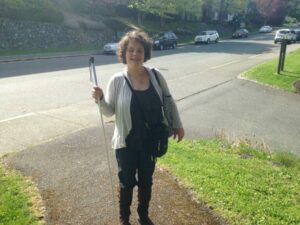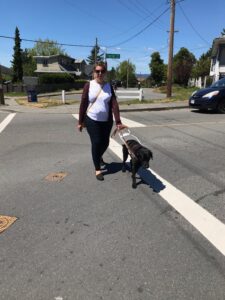
Editor’s Note: The first full week in February is White Cane Week in Canada, a time to bring awareness to topics about blindness and vision loss. This is the first in a 2-part series contrasting the pros of white canes and guide dogs. This part focuses on the pros of a white cane, while part 2 focuses on the pros of a guide dog.
There are three main methods a person who is blind can use for navigating their environment: taking someone’s elbow and following them (known as “Sighted guide” or “human guide”, using a white cane, and working with a guide dog. Diagnosed with a degenerative eye condition in 2007, I have many years of experience using both a white mobility cane and a guide dog. Although my first preference is working with a guide dog for my personal orientation and mobility, I have come to value using both a white cane and a guide dog.

There are specific environments in which I prefer to use my white cane rather than work my guide dog. For example, attending medical appointments at the hospital it is easier for me to use my white cane. Over the past three years, I need to go routine screening at the hospital, and it would be unsafe for my dog to accompany me. Although my guide dog legally can accompany me most places, there are situations where I find it is easier and safer for my dog to leave him at home. My white cane is convenient as it folds up, and I can tuck it away in my bag or purse when it is not in use. I do not have to relieve my white cane.
A White Cane finds objects and obstacles that are in my environment. Knowing where some obstacles are located on my path, can provide useful information regarding my surroundings. Certain objects such as: a sign, a bus stop, bench, fire hydrant on a certain street corner, or in front of a business that I may often go, it would be valuable to know this tactile information and be able to use it as a landmark, and it could also help me to orientate myself. When working my guide dog, my dog Barney often guides me around most of these obstacles, and I may not even know these objects exist along my route.

As I mentioned above the white cane can be folded up, and tucked away easily. I can also pick up and go with my cane, and not have to schedule time in my day to relieve my dog as part of my excursion.
I can only speak from my personal experience, however I find it is far easier for myself to navigate winter conditions such as snow, ice, and snow banks with my cane, than with my guide dog. My white cane even finds a patch of ice on the sidewalk before I step forward. When trying to navigate snow and icy conditions with my dog, he was not trained to work in these circumstances. Living on the West Coast of British Columbia, we also do not have a lot of snowfall for my guide dog to gain exposure to working in these conditions. My guide dog wants to guide me on a clear path free of snow. My dog Barney has even tried to guide me into the street because it is free from snow, not only is this very unsafe, but I can understand his logic behind it if the street is clear and free of cars and other obstacles including snow! Snow banks are a huge hurdle for my dog to navigate, and he either stops and does not know what to do, or when I give him the verbal command “Hop-up”, instead of carefully climbing a snow bank, he has leaped into the air in an attempt to jump the snow bank. Both times he tried to jump a snow bank, I went flying through the air! With my white cane, I can hold my cane using a pencil grip placing my cane into the snow to get my bearing and knowing how deep the snow is, and where it may be best to take my next step. During the recent snowfall, I almost felt as if my white cane was like a ski pole in the snow, just not as effective as a ski pole. At times, my white cane was briefly stuck in the snow. It is never easy to navigate sidewalks after a snowfall when sidewalks have not been shovelled, but from my perspective, walking with my white cane and taking transit has been safer and more convenient to navigate winter snow conditions.
When using my white cane, I receive less attention from others in public around me. When I am out with my guide dog, I am constantly having people asking me if they can pet my guide dog, or asking me questions about my dog and or my vision loss. Although most people are curious, and pleasant to talk to, sometimes it is nice to just go about my day without having people stop me or talk to me everywhere I go. Although I am a guide dog handler, I still make an effort to use my white cane twice per week. I believe it is very important maintain my cane and mobility skills. I would never take my guide dog for example to a fireworks celebration, a zoo, or even a football game. It isn’t that I am not permitted to take my guide dog to such events, my preference is to leave him at home, and it is easier to use my white cane in settings such as these. There also will be times that my guide dog may be lame or sick and unable to work. I cannot solely rely on being able to work my guide dog 100% of the time. Unfortunately, there are times when a guide dog unexpectedly has an illness, or has to retire for unforeseen reasons.
Access issues exist in society for all persons with disabilities. Although there is legislation to protect the rights of a guide dog team, there are countless times I have personally been denied access with my guide dog to access public settings and services such as taxi cabs, and had challenges when travelling and accessing hotel accommodations. I am a confident and strong self-advocate and can usually navigate these barriers when they arise, however, it is a hassle. At times I have had taxi drivers flat-out refuse me service with my guide dog, other times I have had drivers ask me if they can put my guide dog in their car trunk. I feel like I am always educating others regarding guide dog etiquette. When using my white cane, I do not have to deal with these challenging guide dog access issues.
The majority of people who are blind in North America use a white cane for mobility. The white cane provides useful and important information of our environment: obstacles, curbs, changes in elevation, even the sound of the cane on various surfaces can provide valuable information regarding the environment. My personal journey with vision loss is one of continual learning. I am motivated to keep up with learning new skills when it comes to orientation and mobility with using a white cane and my guide dog. I am an active and independent person and it is very important to continue my learning journey to further enhance my independence and my goals and aspirations in life.